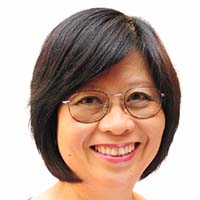How UW Tacoma faculty are enhancing teaching with technology
In a new report from the UW Provost's office, 16 UW faculty, including seven from the Tacoma campus, describe how they are embracing innovation to enhance their pedagogy.
This Section's arrow_downward Theme Info Is:
- Background Image: ""
- Theme: "light-theme"
- Header Style: "purple_dominant"
- Card Height Setting: "consistent_row_height"
- Section Parallax: "0"
- Section Parallax Height: ""
A new report from the UW Provost's Office highlights the stories of 16 faculty who are exceeding the challenge presented by President Michael Young ... to be innovators in the changing world of public higher education. Seven of the featured faculty members teach at UW Tacoma.
Each of the brief profiles in the report demonstrates how students and instructors are benefiting from using technology to enhance pedagogy, and offers advice for other faculty interested in exploring new tools and formats.
The UW Tacoma faculty highlighted are Matthew Kelley, Belinda Louie, Riki Thompson, Douglas Wills, Nita McKinley, Alissa Ackerman and Tracey Haynie. You can download the full report, or read the individual profiles of UW Tacoma faculty below.
Accordions don't have settings which need debugging arrow_downward

Alissa Ackerman, Assistant Professor, Social Work, UW Tacoma |
Dr. Ackerman, an assistant professor of social work at UW Tacoma, was a 2012 UW Tacoma Tech Fellow. She has used Twitter in and out of the classroom to engage students in a broad conversation about criminal justice issues. Twitter: “Setting up Twitter was the easy part for all. Operating Twitter was a little more difficult for students. I created a ‘how to’ document for them to follow, which seemed to shorten the learning curve. Within a week or two, most students were using Twitter effectively.” Student reactions: “Student reactions have been mixed. Some students love the instant interaction.” Benefits for students: “I believe that Twitter enhances student learning. This is especially true when I have invited ‘guest lecturers’ to class via Twitter. I have done this with authors of books, journalists, and other scholars. This allows students to benefit from the reactions of others in the field in real time. Another added benefit occurs when the students ‘tag’ authors of articles and the author responds directly to them.” Brevity requires focus: “I believe that having to condense one’s thoughts into 140 or so characters provides focus. Some students welcomed this challenge, while others would much prefer the traditional essay.” Leveraging social media expertise: “Students already know how to use social media, but learning how to do so in a professional and articulate way can only benefit them in the long run!” Advice to other faculty interesting in using Twitter: “Be patient and have a lot of structure regarding what you want from students.” |

Tracey Haynie, Lecturer, Interdisciplinary Arts & Sciences, UW Tacoma |
Ms. Haynie, a statistics lecturer in the Interdisciplinary Arts & Sciences department at UW Tacoma, is teaching the first online math classes at the Tacoma campus, with one section of pre-calculus, and another of section of introductory statistics. She notes, “As most people would agree, math is a tricky subject, and we knew it would be a challenge.” Keeping students on track: She has been piloting a tool called Persistence Plus, which gives students electronic ‘nudges’ via their mobile device — about due dates, upcoming quizzes and exams, and motivational text messages. She says, “The initial set up was not too difficult.” Student reactions: “I have only heard positive feedback from students. Many students said they found the reminders about due dates to be extremely helpful, and the other thing they specifically mentioned loving were the motivational texts. It gave them a little boost to study harder, or go find a study group to meet with.” Access: “With a growing number of military personnel and older students returning to earn a degree, we felt it was critical to offer them a variety of options to fit their schedules and lifestyles.” Advice: “Just try it! It doesn’t have to be permanent, and if you try it and decide your students don’t benefit from it, then you can scratch it.” Link: Educause Review online article about the pilot, “Analytics, Nudges, and Learner Persistence”, by Tracey Haynie, Jill Frankfort, Kenneth Salim, and Colleen Carmean |

Matthew Kelley, Assistant Professor, Urban Studies, UW Tacoma |
Dr. Kelley, an assistant professor in the Urban Studies program at UW Tacoma, has been teaching online for several years and recently started to use the Canvas learning management system. Value of Canvas: “Canvas has been great. Its analytics are a significant improvement” over other learning management systems. Online flexibility: “I am not tethered to a particular place or a particular time in order to deliver my curriculum. Using little more than a mobile phone or tablet, I can participate in the class, grade assignments, or troubleshoot via email.” Benefits for the instructor: “I am able to teach at times that are most suitable to my own rhythms — this means I can get my writing and research done during daytime hours (when collaborators are around, when the library is open, when computer labs are available, etc.). I notice considerably more flexibility in my research schedule.” Benefits for students: He appreciates “getting to hear students’ voices in a way that is not possible in the face-to-face environment.” Advice: “Design an explicit and logical schedule” so that students are clear on due dates and expectations. He adds, “Most likely, the first two times you teach a new online course it will be difficult (more work than teaching face-to-face), but after the kinks are worked out, it does get easier and more rewarding.” |

Belinda Louie, Professor, Education, UW Tacoma |
Dr. Louie, a professor in the Education department at UW Tacoma, was a 2012 UW Tacoma Tech Fellow and developed “Methods and Curricula in Literacy Instruction for English Language Learners” (TEDUC 564) into an online course. It is one of five required courses for teachers who would like to be certified in English as a Second Language in Washington state. Access: “Online courses allow teachers flexibility and increase their access to muchneeded professional development. If they cannot come to me, I will bring the training to them.” Efficacy of online instruction: “I see online courses as an alternate form of course delivery, neither superior nor inferior to face-to-face classes, just different.” Benefits for students: “Teachers need the professional development; however, it is difficult for them to come to campus to take courses after a long day of work at school. Teachers in smaller districts, such as the Yakima Valley, have limited professional development opportunities.” Advice: “Have clear goals for converting a face-to-face class to online. It takes much mental energy and hard work to launch the first online course.” Resource: One of the videos Dr. Louie uses in TEDUC 564, in which she interviews a local expert on teaching English as a second language. |

Nita McKinley, Associate Professor, Interdisciplinary Arts & Sciences, UW Tacoma |
Dr. McKinley, an associate professor of psychology in the Interdisciplinary Arts & Sciences program at UW Tacoma, was a 2012 Tech Fellow and taught “Lifespan Development” (TPSYCH 220) as a hybrid course in 2012. She says: “For me, this was an intermediate step toward learning to do it online” and as of winter quarter 2013, she is teaching the course completely online. She adds that she plans to convert her class “Body Image and the Psychology of Appearance” (TPSYCH 405) to a hybrid course next year. Benefits for students: “I find it difficult to have any meaningful discussion in a large class; frequently, just a few students participate and the majority are silent. By adding an online component where students worked in small groups (five to six people) to discuss a topic, come up with a position, and write a group position paper together, I believe more students were much more engaged in the discussion.” Student learning: “My impression was that more students were engaged in discussion. I also thought the papers produced were equivalent or better in quality to papers I get in other classes.” One successful approach: “I found the FAQ discussion board useful. It meant I didn’t have to answer the same question multiple times by email. It did take some training on my part to get students to post questions rather than email me.“ Why try it? “For me, developing the online course has been very exciting and challenging. I’ve enjoyed learning the technology and thinking about my teaching in new and creative ways.” |

Riki Thompson, Assistant Professor, Interdisciplinary Arts & Sciences, UW Tacoma |
Dr. Thompson is an assistant professor of Rhetoric and Composition in the Interdisciplinary Arts and Sciences department at UW Tacoma. In her writing courses, she has often used technology tools such as Camtasia to grade student essays using a form of video feedback that has been dubbed ‘veedback’. Dr. Thompson and a colleague recently published an article in The Journal of Interactive Technology and Pedagogy (JITP) about their experiences with the tool, concluding that “screencast video feedback serves as a better vehicle for in-depth explanatory feedback that creates rapport and a sense of support for the writer than traditional written comments.” The goal: “My goal is to find a way to use the more informal communication technology tools to help students understand that I am having a conversation with them about their paper, not editing it. I’m trying to create a change around how we teach writing.” Benefits for students: “The main thing is that this audio format gets rid of the red pen in feedback. It moves to a conversational format. When I give feedback through veedback, students say, ‘I can hear you talking to me,’ and they didn’t seem to be as stressed. I knew that there was something there; that I was making a difference. It’s motivated me to use this tool for this purpose. It feels like a more intimate connection. It’s also changing the power dynamic.” Challenges: “Flexibility and having tools that allow mobility have probably been the biggest challenges with using audio feedback tools for me. The other problem was saving files in a way that was accessible to everybody. At Tacoma, there are still a lot of students who don’t have the latest tools at home, or they’re still working on a really old system that doesn’t have new media cards.” Advice: “Get on the radar of the technology people on campus, and find out who your peers are. Don’t expect that it’s going to take less time; there’s a learning curve and it might take more time. Be flexible and check in with the students throughout the quarter to see if it’s working and if you need to make changes. Mid-quarter assessment is vital when using new tools. You have to be willing to say, okay, we’re going back to paper (or other traditional means). Because if they’re not getting it, students fail to learn the content, and that’s not worth it.” |

Douglas Wills, Associate Professor, Milgard School of Business, UW Tacoma |
Dr. Wills, an associate professor in the Milgard School of Business at UW Tacoma, has been flipping his economics classes — both for undergraduate and MBA students — for years. As a UW Tacoma Tech Fellow, he also developed an online “Introduction to Microeconomics” (TECON 200) class during summer 2012. Benefits of flipping: “Flipping the classroom opened up possibilities that have made teaching much more exciting and rewarding. To go back to the standard chalk and talk (or more accurately now, ‘PowerPoint and talk’) with largely unengaged students is now inconceivable.” Benefits for the instructor: “I am much more involved in my classes, not only because the interaction with students is so much more useful and enjoyable, but there are so many more possibilities.” Advice: “If you’re thinking of doing it to improve your teaching, then be prepared for a lot of investment of time and be prepared to innovate and experiment. There is a lot of value in learning from others about the technology (and no, it’s not really about the technology) and basic principles of hybrid/online.” Why try it? “You only learn how to do this well by doing it.” |
Recent news
Main Content
Gathering Strength
News Tags on this arrow_upward Story:
- None
Main Content
UW Tacoma Enrollment up 4% for Autumn 2024
News Tags on this arrow_upward Story:
- None
Main Content
Celebrating First Gen
News Tags on this arrow_upward Story:
- None



